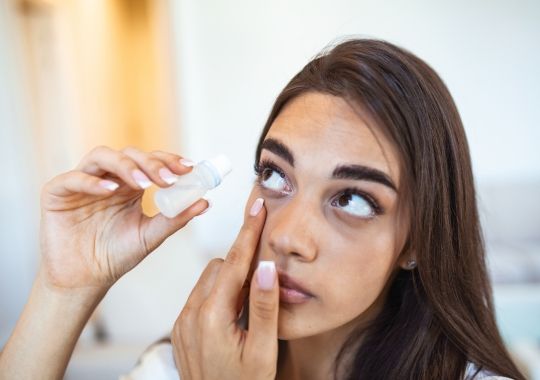Smoking's impact on eye health is a topic of significant concern, particularly regarding the question of what does smoking do to eyes. Various ocular conditions, including cataracts and age-related macular degeneration, have been linked to smoking. Additionally, smoking can irritate the eyes, exacerbating dry eye symptoms.
As Amazon affiliates we may earn a commission if you purchase a product at no cost to you.
What Smoking Does to Your Eyes
Smoking can have detrimental effects on eye health:
Increased Risk of Eye Diseases: Smoking is linked to an increased risk of various eye diseases, including age-related macular degeneration (AMD), cataracts, and glaucoma. These conditions can lead to vision loss and blindness if left untreated, making it crucial for smokers to be aware of the risks and take preventive measures.
Impact on Blood Flow: Smoking can reduce blood flow to the eyes, affecting their overall health and function. Reduced blood flow can contribute to the development and progression of eye diseases, further exacerbating the damage caused by smoking.
Dry Eyes and Irritation: Smoking can also contribute to dry eyes and irritation. The chemicals in tobacco smoke can irritate the eyes, leading to symptoms such as redness, burning, and discomfort. Smokers may experience these symptoms more frequently, affecting their overall eye comfort and quality of life.
Secondary Effects: Additionally, smoking can have secondary effects on the tissues surrounding the eyes, causing puffiness and disorders of the eyelids. These effects can further impact eye health and contribute to the development of various eye conditions, highlighting the importance of quitting smoking to preserve vision and overall eye health.
Smoking can significantly impact eye health by increasing the risk of various eye diseases, reducing blood flow to the eyes, causing dryness and irritation, and leading to secondary effects on the surrounding tissues. Smokers should be aware of these risks and consider quitting smoking to protect their vision and maintain optimal eye health.

Specific Eye Conditions Linked to Smoking
Smoking is associated with various eye disorders:
Age-Related Macular Degeneration (AMD): Smoking increases the risk of AMD, a condition that causes damage to the macula, leading to central vision loss.
Cataracts: Smoking is a risk factor for the development of cataracts, a condition characterized by clouding of the lens in the eye, leading to blurry vision.
Diabetic Retinopathy: Individuals who smoke are more likely to develop diabetic retinopathy, a complication of diabetes that affects the blood vessels in the retina, leading to vision loss.
Dry Eye Syndrome: Smoking can exacerbate dry eye syndrome, a condition characterized by insufficient tears to lubricate the eye, leading to discomfort and vision problems.
These eye conditions can significantly impact vision and quality of life. Quitting smoking can reduce the risk of developing these disorders and improve overall eye health. We recommend you to check out some eyedrops below to help maintaining the health and lubrication of the eyes
GenTeal Tears Lubricant Eye Drops.
LUMIFY Redness Reliever Eye Drops.
Biotrue Hydration Boost Eye Drops.

Effects of Smoking on Tear Production
Smoking has been shown to have significant detrimental effects on tear production and overall eye health, ultimately leading to dry eye syndrome. Tear production plays a crucial role in maintaining the health and lubrication of the eyes, and any disruption in this process can result in discomfort and vision problems.
One of the primary ways smoking affects tear production is through the induction of oxidative stress and inflammation in the ocular surface tissues. The toxic compounds present in cigarette smoke, such as nicotine and reactive oxygen species, can directly damage the delicate structures of the tear film, including the lipid layer. This damage disrupts the normal function of the tear film, leading to increased tear evaporation and decreased tear stability.
Additionally, smoking can compromise the integrity of the lacrimal glands, which are responsible for producing the aqueous component of tears. Chronic exposure to smoke can impair the blood flow to these glands and interfere with their ability to produce an adequate volume of tears. As a result, individuals who smoke may experience a reduction in tear production, exacerbating the symptoms of dry eye syndrome.
The symptoms of dry eye syndrome caused by smoking can vary in severity but often include irritation, grittiness, burning sensation, and redness in the eyes. These symptoms can be persistent and significantly impact daily activities such as reading, using digital devices, or driving. Moreover, dry eye syndrome can also lead to blurred vision and increased sensitivity to light, further impairing visual function.
Furthermore, smoking-induced dry eye syndrome is not only uncomfortable but also increases the risk of developing other ocular complications. Prolonged tear film instability and ocular surface inflammation can predispose individuals to corneal abrasions, infections, and even vision-threatening conditions such as corneal ulcers. Therefore, addressing the effects of smoking on tear production is crucial not only for relieving symptoms but also for preserving long-term ocular health.
Smoking can have profound effects on tear production, leading to the development of dry eye syndrome and associated symptoms. The toxic components of cigarette smoke disrupt the tear film structure and compromise the function of the lacrimal glands, resulting in reduced tear volume and stability. Individuals who smoke may experience discomfort, irritation, and vision disturbances due to dry eye syndrome, highlighting the importance of smoking cessation as part of comprehensive eye care. By quitting smoking and adopting healthy lifestyle habits, individuals can mitigate the adverse effects on tear production and maintain optimal eye health.
Recommended Article

Frequently Asked Questions FAQs
How does smoking affect eye health?
Smoking can have detrimental effects on eye health, leading to various conditions such as cataracts, macular degeneration, uveitis, and dry eye syndrome. The toxic components of cigarette smoke can damage the delicate structures of the eye, impair tear production, and compromise blood flow to ocular tissues, ultimately increasing the risk of vision loss and blindness.
What eye diseases are linked to smoking?
Several eye diseases are associated with smoking, including age-related macular degeneration (AMD), cataracts, diabetic retinopathy, and uveitis. Smoking increases the likelihood of developing these conditions due to its harmful effects on ocular blood vessels, retinal tissue, and tear film stability.
Can smoking contribute to vision loss and blindness?
Yes, smoking can contribute to vision loss and blindness by damaging essential parts of the eyes necessary for maintaining clear eyesight and vision. Smoking-induced conditions such as AMD, cataracts, and uveitis can lead to severe visual impairment if left untreated. Quitting smoking is essential to reduce the risk of developing these sight-threatening conditions and preserving overall eye health.
Conclusion
In the quest to understand "What does smoking do to eyes?", smoking has detrimental effects on eye health, contributing to various ocular conditions such as age-related macular degeneration, cataracts, and glaucoma. Studies have shown that smoking can reduce blood flow to the eyes, increasing the risk of conditions like glaucoma. Additionally, smoking can lead to dryness of the eyes and deterioration of the tear film.










